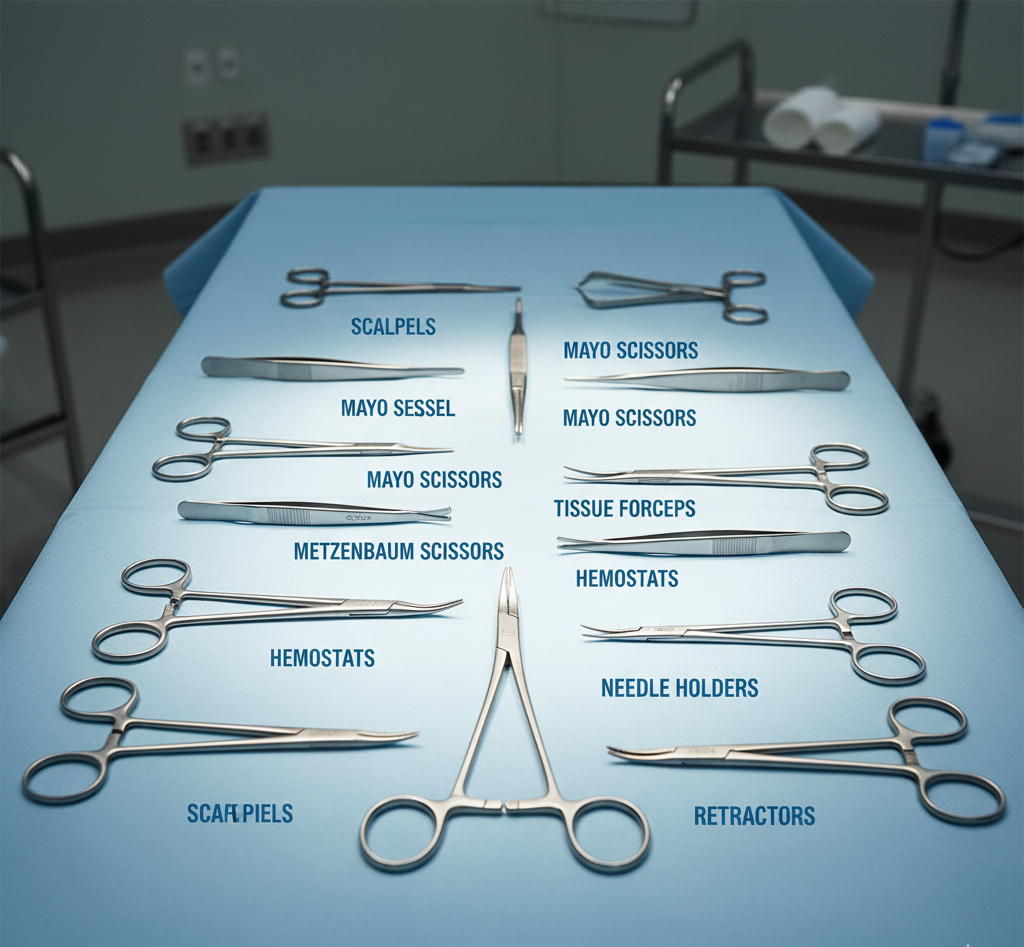Meta Description (SEO-Friendly)
Learn about general surgical instruments with names, uses, categories, material types, and hospital selection criteria. A complete guide for students, hospitals, distributors, and surgical instrument manufacturers.
Introduction
General surgery is the foundation of modern medical practice, and at the heart of every successful procedure are general surgical instruments. Understanding general surgical instruments with names helps surgeons, students, nurses, hospital procurement officers, and medical equipment distributors identify the correct tools for each procedure. These instruments are designed for cutting, dissecting, holding, retracting, clamping, suturing, and measuring.
In this detailed guide, we will cover the most commonly used general surgical instruments with names, their categories, usage fields, materials, sterilization methods, and quality standards. This is a complete resource for anyone seeking authentic knowledge about basic surgery tools.
What Are General Surgical Instruments?
General surgical instruments are medical tools used in routine surgical procedures such as abdominal surgery, plastic surgery, trauma surgery, emergency procedures, and soft tissue surgeries. These are the essential instruments present in every operation theater (O.T).
They must be:
✅ Durable
✅ Corrosion-resistant
✅ Easy to sterilize
✅ Ergonomically designed
✅ Safe and precise
Main Categories of General Surgical Instruments
General surgical instruments are divided based on their function:
| Category | Purpose | Examples |
|---|---|---|
| Cutting & Dissecting | Cutting tissue or skin | Scalpels, Metzenbaum scissors |
| Grasping & Holding | Holding tissue/needles | Tissue forceps, needle holders |
| Clamping & Occluding | Controlling bleeding | Hemostats, artery forceps |
| Retracting & Exposing | Holding back organs | Senn retractor, Weitlaner |
| Suturing | Closing incisions | Needle holders, suturing scissors |
| Probing & Dilating | Examining cavities | Grooved director, dilators |
| Measuring | Depth / length measurement | Depth gauge |
✅ General Surgical Instruments with Names and Uses
Below is the most complete list of general surgical instruments with names and their functions:
1. Cutting & Dissecting Instruments
| Instrument Name | Use |
|---|---|
| Scalpel (Handle + Blade) | Skin & tissue cutting |
| Metzenbaum Scissors | Fine tissue dissection |
| Mayo Scissors (Straight) | Cutting sutures |
| Mayo Scissors (Curved) | Cutting heavy tissue |
| Surgical Blade #10 / #11 / #15 | General incision |
| Bone Chisel | Bone cutting |
| Osteotome | Bone shaping |
2. Grasping & Holding Instruments
| Instrument Name | Use |
|---|---|
| Tissue Forceps (Toothed) | Holding skin / tissue |
| Dressing Forceps (Non-Toothed) | Holding dressings / gauze |
| Needle Holder (Mayo-Hegar) | Holding needle during suturing |
| Adson Forceps | Plastic / soft tissue surgery |
| Thumb Forceps | Basic tissue handling |
3. Clamping & Occluding Instruments
| Instrument Name | Use |
|---|---|
| Hemostatic Forceps | Control bleeding / clamp vessels |
| Mosquito Forceps | Small vessel clamping |
| Kelly Forceps | Medium vessel clamping |
| Crile Forceps | General hemostasis |
| Kocher Forceps | Grasping heavy tissue |
4. Retracting & Exposing Instruments
| Instrument Name | Use |
|---|---|
| Senn Retractor | Small incisions |
| Weitlaner Retractor | Self-retaining retraction |
| Gelpi Retractor | Deep retraction |
| Army-Navy Retractor | Soft tissue retraction |
| Richardson Retractor | Abdominal wall lifting |
5. Suturing Instruments
| Instrument Name | Use |
|---|---|
| Needle Holder | Holds needle for suturing |
| Iris Scissors | Cutting fine sutures |
| Suture Scissors | Cutting sutures post-operation |
| Staplers | Skin closure |
6. Suction & Aspiration
| Instrument Name | Use |
|---|---|
| Yankauer Suction | Removing blood/fluid |
| Poole Suction | Abdominal fluid suction |
7. Measuring / Probing
| Instrument Name | Use |
|---|---|
| Grooved Director | Guiding incision |
| Probe | Exploring cavities |
| Depth Gauge | Measuring incision depth |
Materials Used in General Surgical Instruments
| Material | Advantage | Common Use |
|---|---|---|
| Stainless Steel | Durable & corrosion-resistant | Most instruments |
| Titanium | Lightweight, non-magnetic | Specialty tools |
| Tungsten Carbide | Extra hardness | Scissors / needle holders |
Sterilization Methods
| Method | Description |
|---|---|
| Steam Autoclave | Most common & safest |
| Dry Heat | For sharp tools |
| Plasma Sterilization | For delicate instruments |
| Chemical Sterilization | For heat-sensitive tools |
How to Choose the Best General Surgical Instruments
✅ Check ISO / CE / FDA certification
✅ Prefer German or medical-grade steel
✅ Test grip and ergonomics
✅ Choose reusable when possible
✅ Inspect finish and alignment
SEO Long-Tail Keywords (Included in Article)
- general surgical instruments with names
- list of surgical instruments and their uses
- basic surgical instruments for hospitals
- stainless steel surgical instruments
- operating room general instruments
- reusable general surgical tools list
Frequently Asked Questions (FAQs)
1. What are the most common general surgical instruments?
Scalpel, mayo scissors, hemostatic forceps, tissue forceps, and retractors.
2. Which instruments are used to cut tissue?
Metzenbaum scissors and scalpels.
3. What is the use of forceps in surgery?
Forceps are used for holding, grasping, and manipulating tissue.
4. How are surgical instruments sterilized?
Mainly through steam autoclaving.
5. What material is best for surgical instruments?
German stainless steel (AISI 410, 420, 440C) is preferred.
Conclusion
Understanding general surgical instruments with names is essential for both medical learners and healthcare procurement teams. These instruments form the backbone of every surgery and must be chosen based on precision, durability, and safety standards. The higher the quality of instruments, the better the surgical outcome and patient care.

